Canna lily leaves will naturally turn brown when the weather turns cold in fall and winter. The plants will die back, recapturing the nutrients from the stems and leaves into the rhizomes. The leaves will turn brown and die back. Cut the stems off 5 inches from the soil and the rhizomes will grow back in spring.
There are some other causes of brown leaves on canna lilies. This can include pests and diseases such as canna rust, underwatering and pest attack.
This article will explore the top causes of canna lily leaves turning brown and how to solve each one. Most of these problems are easy to solve and will save your plant.

Causes of brown leaves on canna lily plants
Here are the top causes of brown leaves on canna lily plants. Check out each of these and easy solutions to save your canna lily plants.
1. Winter weather
Canna lily leaves will naturally turn brown and die back over fall and winter. Canna lilies grow over spring and summer where they will grow long stems, beautiful flowers and large leaves. They love warm weather, humidity and summer sun.
When the weather turns cold in fall, the canna lilies will naturally go into hibernation. Any time from early fall to late winter the leaves will turn brown from the edges inwards. Eventually the stems will start to brown too.
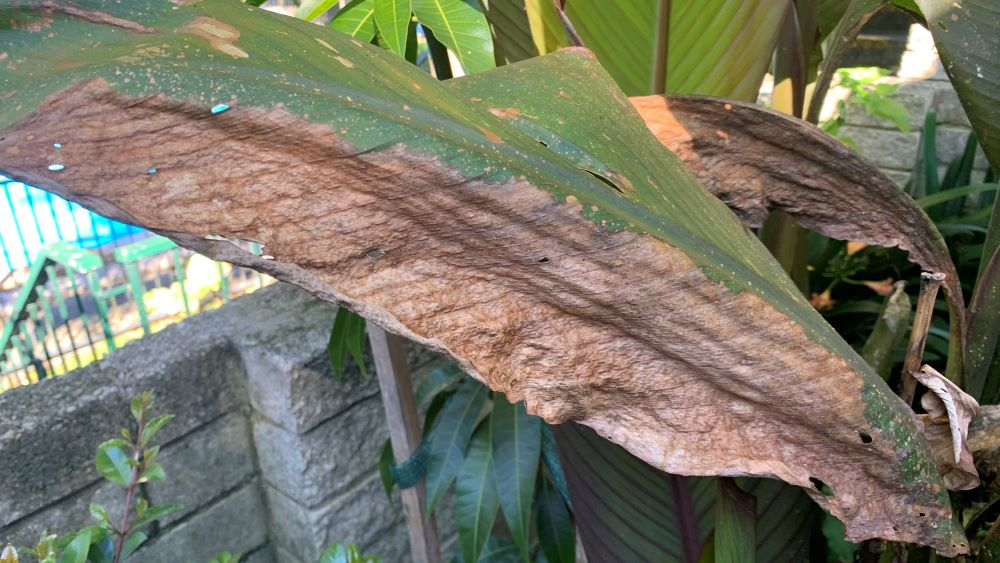
Wait until the stems are brown if you can then cut them back 5 inches from the ground. I like to surround my stems with bark mulch to protect the stems and roots over winter. When spring arrives, the rhizomes will send up new shoots and will grow again.
Canna lilies will naturally develop brown leaves and die back over winter, so don’t worry. They will grow back in spring.
2. Canna lily rust
Canna lily rust is a common problem with these plants which causes brown, red or ‘rust’ colored marks on the leaves. Eventually the leaves and plant can die back, turning the leaves brown and damaging the plant. Too much water and warm temperatures can cause this rust to grow fast.
Canna lily rust is fungal disease that is common if plant’s leaves get excess water on them. This fungus grows on the large leaves developing these marks. If you are getting a lot of rain or if you are watering the plant on the leaves they can develop rust.
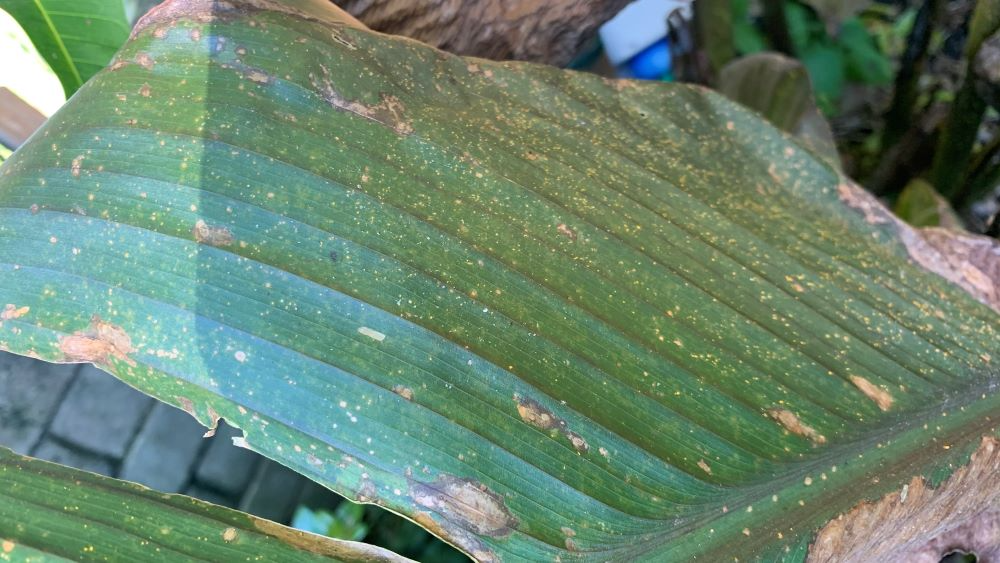
My canna lilies usually develop rust towards the end of their growing season in fall when the weather cools and the rain stays longer on the leaves.
An easy solution if it occurs in fall or winter is to cut your canna lily stems back. This will remove the rust and the stems will grow back healthily in the next spring.
I find that when the weather is warmer and the leaves are fast growing they do not develop the rust.
Always avoid watering directly on the leaves which will encourage fungal growth.
3. Underwatering
Underwatering canna lilies can lead to brown leaves. Rhizomes that are allowed to dry out too much can develop brown leaf edges which will eventually spread to the stem. Canna lilies like tropical or subtropical weather with lots of rainfall over summer.
If you are getting low amounts of rain over summer then you will need to top up the cannas with water. Deep water the rhizomes with your hose. Repeat this 1-2 times per week over the warmer weather.
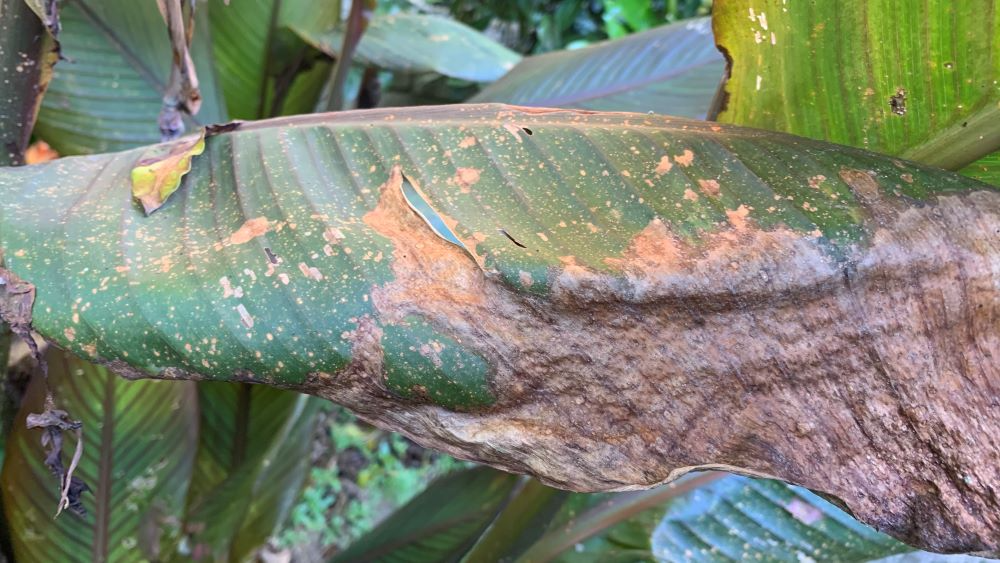
If your canna lilies are growing in pots then they will be more reliant on you for water. Potting soil will dry out faster than ground soil so you will need to check them regularly.
Stick your finger or a popsicle stick in the soil 2 inches down. If the soil is dry then water the plant at the root zone. Keep the water off of the leaves to avoid rust.
4. Pest attack
Pests can attack canna lily leaves causing holes, brown spots or marks on the edges. Caterpillars, slugs and snails can all attack canna leaves biting the edges or holes in the leaf. This will cause the leaf edges and holes to turn brown.
Sap-sucking insects like aphids, scale and spider mites can all attack canna leaves. These sap sucking insects can cause damage to the leaves causing them to turn brown or yellow.
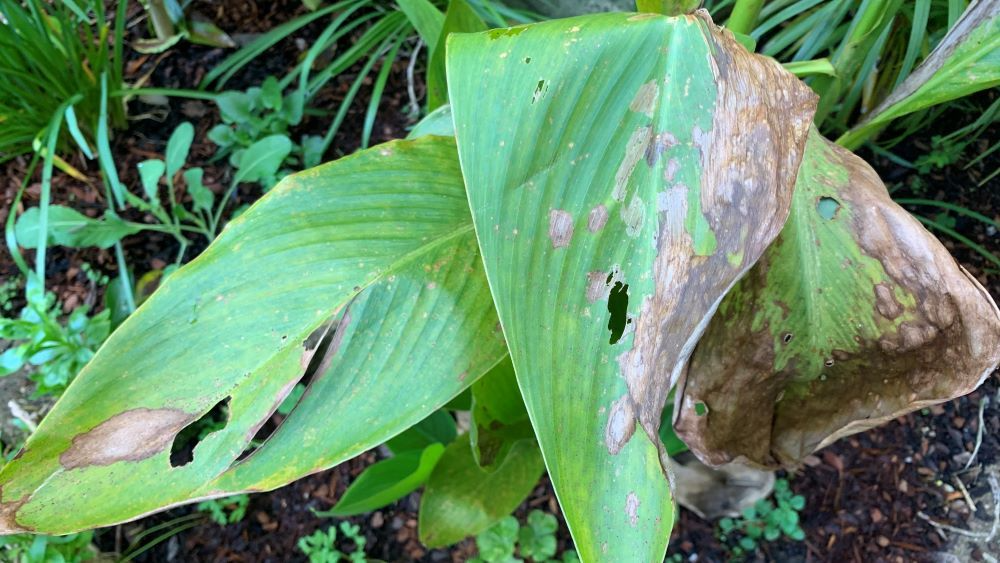
Neem oil is an easy way to treat sap sucking insects. This natural concentrated oil extracted from the neem tree can be sprayed on the leaves and stems of cannas to treat these pests.
It is easy to pick off snails, slugs and caterpillars with gloved hands. Shake them into a bucket of soapy water and tip them out far away from your cannas. You can surround your cannas with crushed egg shells or used coffee grounds to keep snails and slugs away.
5. Lack of nutrients
Canna lilies are hardy plants but if they are not getting the nutrients they need their leaves can turn brown or yellow. Compacted soil can stop the rhizomes from getting the nutrients they need. A soil that lacks nitrogen can cause the leaves to turn brown.
To prevent the canna lily leaves from suffering from a lack of nutrients build up the soil before planting your rhizomes. I like to mix through a whole bag of aged cow manure and compost. Dig this through your soil with a garden fork and create a small mound to increase drainage.
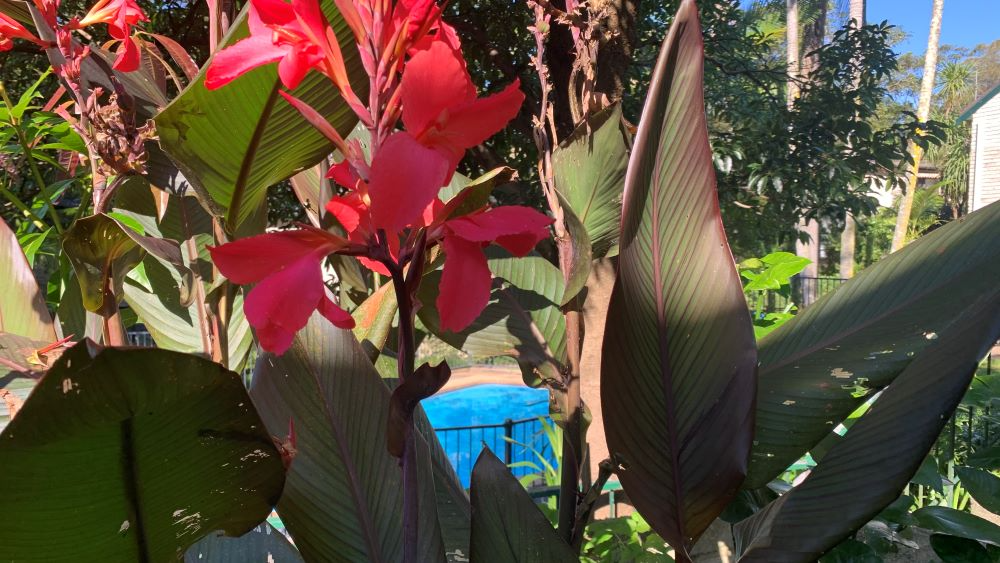
Add a handful of pelleted chicken manure to add some extra nitrogen.
If your rhizomes are in the ground or in a pot, add pelleted chicken manure or give them a dose of liquid fertilizer that contains a balance of nitrogen, potassium and phosphorus.
6. Too Much Fertilizer
Too much fertilizer can lead to brown of canna lily leaves Adding too much fertilizer, particularly nitrogen-rich fertilizers, can cause fertilizer burn. Extra nitrogen can “burn” the plant’s roots and foliage. This occurs because high levels of salts in the fertilizer can draw water out of plant cells, damaging them.
Too much fertlizer can also can also harm the plant’s root system, reducing its ability to take up water and nutrients. This can lead to drought stress and nutrient uptake issues, further contributing to leaf browning.
To prevent adding too much fertilizer and nutrients, use a balanced fertilizer with an N-P-K (nitrogen-phosphorus-potassium), apply fertilizer according to the manufacturer’s recommendations, use slow release fertilizer and apply it at the start of spring and water the plant thoroughly after fertilizing.
7. Sunlight Exposure
Getting the correct balance of sunlight for your canna lilies is important. If your plant is not getting enough sunlight, its leaves may start to turn brown. If your canna lily is exposed to too much direct sunlight, it can also cause the leaves to brown. I find that the best location for canna lillies is a position that gets at least 4-6 hours of mornign sunlight wiht shade in the afternoon. This will give you loads of flowers and healthy leaves.
How to Prevent Brown Canna Lily Leaves
Here are some easy techniques to keep your canna lilies healthy and vibrant.
Proper Watering Techniques
Overwatering is one of the most common causes of browning in canna lily leaves. Check the soil moisture level before watering and water only when the soil is dry to the touch. Make sure that the soil is well-draining and does not hold excess water. Avoid getting water on the leaves and flowers as it can lead to rust.
Ideal Sunlight Conditions
Canna lilies require plenty of sunlight to grow and bloom, but too much direct sunlight can cause the leaves to turn brown. Make sure your canna lilies get partial shade during the hottest part of the day. You can also move your plants to a cooler spot during heatwaves.
Fertilizers
Canna lilies require a balanced supply of nutrients to grow and thrive. Make sure that the soil is rich in nitrogen, phosphorus, and potassium. Feed them with a slow-release fertilizer in spring to provide your plants with a steady supply of nutrients. Too much fertilizer lead to leaf burn and other problems.
Pest Control Measures
Pests like spider mites, aphids, and thrips can damage canna lily leaves and cause them to turn brown. To prevent this, inspect your plants regularly for signs of infestation. Use insecticidal soap or Neem oil to control sap sucking pests.
For some easy tips on pruning your cannas to get more flowers, check out this video.
How to Save Canna Lillies with Brown Leaves
If you notice brown leaves on your canna lily plant, it’s important to act quickly to save your plants.
- Trim off the brown leaves: The first step to reviving brown canna lily leaves is to trim them off. Use sharp, clean scissors or pruning shears to cut off the brown leaves at the base of the stem. Be sure to sterilize your tools before and after use to prevent the spread of disease.
- Watering: Water your plant deeply and infrequently, rather than giving it frequent shallow waterings. This will encourage deep root growth and help the plant withstand drought. Be sure to water the plant at the base, rather than getting the leaves wet.
- Fertilizing: Use a balanced fertilizer with equal parts nitrogen, phosphorus, and potassium, and apply it during the growing season in spring.
- Mulching: Mulching around the base of your canna lily plant can help to keep the moisture in and regulate soil temperature. Use a layer of organic material such as compost, straw, or leaves, and apply it to a depth of 2-3 inches.
- Pest Control: Some pests, such as spider mites and thrips, can cause brown spots on canna lily leaves. Use an insecticidal soap or neem oil to control these pests, and be sure to follow the instructions carefully.
By following these tips, you can help to revive your canna lilies with brown leaves and keep your plant healthy and thriving.
Why do canna lily leaves turn brown? | Summary
Canna lily leaves will naturally die back and turn brown over the winter months. If you live in a mild or tropical climate, cannas can grow all year round but eventually the mature stems will die back. They will be quickly replaced with new stems if the weather is still warm. Check the leaves closely for bugs or fungus and deal with the problem quickly. You can save your plants and get great flowers and new stems in no time.
I am an accredited practicing dietitian, experienced gardener and a dedicated cook. I love writing and sharing my experience so you can learn from my successes and mistakes.
